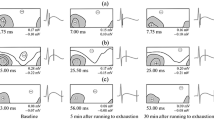Abstract
As a result of hemodynamic and structural changes occurring in the heart of athletes under the influence of systematic physical loads, the myocardial electrical activity changes, which is reflected on the electric field formed on the body surface. The electrical activity of the heart during ventricular depolarization at rest was studied in the highly skilled athletes training to develop physical characteristics (endurance and strength) by the method of electrocardiotopography. The studied athletes had similar patterns of movement of zones of positive and negative cardiac electrical potentials and location of extrema as well as the total depolarization duration but showed significant distinctions in (1) the amplitude of the maximum negative extremum; (2) the time of the beginning and end of the first inversion; (3) the duration of the second inversion, the initial stage, and the stability period between inversions; and (4) the relative position of positive and negative cardiopotential zones.
Similar content being viewed by others
References
Belotserkovskii, Z.B., Lyubina, B.G., and Koidinova, G.A., Cardiac function and physical working capacity of athletes with altered ventricular depolarization, Hum. Physiol., 2009, vol. 35, no. 1, p. 80.
Corrado, D., Biffi, A., and Thiene, G., 12 lead ECG in the athlete: physiological versus pathological abnormalities, Br. J. Sports Med., 2009, vol. 43, p. 669.
Rusanov, V.B., Systemic changes in the central hemodynamics in terms of adaptation to training physical endurance, Vestnik Chelyab. Gos. Ped. Univ., 2009, no. 8, p. 267.
Pelliccia, A., Maron, B.J., De Luca, R., et al., Remodeling of left ventricular hypertrophy in elite athletes after longterm deconditioning, Circulation, 2002, vol. 105, p. 944.
Zemtsovskii, E.V., Sportivnaya kardiologiya (Sports Cardiology), St. Petersburg: Gippokrat, 1995.
Mihl, C., Dassen, W.R.M., and Kuipers, H., Cardiac remodeling: concentric versus eccentric hypertrophy in strength and endurance athletes, Neth. Heart J., 2008, vol. 16, no. 4, p. 129.
Mitchell, J.H., Haskell, W., Snell, P., and Van Camp, S.P., in 36th Bethesda Conference. Task Force 8: Classifications of Sports, Maron, B.J. and Zipes, D.P., Eds., J. Am. Coll. Cardiol., 2005, vol. 45, p. 1364.
Hildick, D.J.R. and Shapiro, L.M., Echocardiographic differentiation of pathological and physiological left ventricular hypertrophy, Heart, 2001, vol. 85, p. 615.
Graevskaya, N.D., Goncharova, G.A., and Kalugina, G.E., Once again the issue of “athlete’s heart,” Teor. Prakt. Fiz. Kul’t., 1997, no. 4, p. 25.
Kartashova, L.A., Kornyakova, V.V., and Smitienko, O.L., Disadaptative cardiovascular markers in athletes engaged in cyclic and acyclic sports according to echocardiographic data, Vestn. Tyumen. Gos. Univ., 2008, no. 3, p. 39.
Pelliccia, A., Maron, B., and Culasso, F., Clinical significance of abnormal electrocardiographic patterns in trained athletes, Circulation, 2000, vol. 102, p. 278.
Roshchevskii, M.P. and Roshchevskaya, I.M., Evolutionary electrocardiology: from electrocardiotopography to laying the foundations for future electrocardiotomography, Med. Akad. Zh., 2005, vol. 5, no. 2, p. 33.
Baum, O.V., Roshchevskii, M.P., and Titomir, L.I., The electric field of the heart: the problems of its study and use to assess the state of the body, in Elektricheskoe pole serdtsa (The Electric Field of the Heart), Moscow: Izd. AN SSSR, 1983, p. 5.
Mirvis, D., Body Surface Electrocardiographic Mapping, Boston: Kluwer Acad. Publ., 1988.
De Ambroggi, L., Musso, E., and Taccardi, B., in Comprehensive Electrocardiology, Macfarlane, P. and Lawrie, T.D., Eds., New York: Pergamon press, 1989, p. 1015.
Roshchevskaya, I.M., Kardioelektricheskoe pole teplokrovnykh zhivotnykh i cheloveka (Cardioelectric Field of Homeothermic Animals and Humans), St. Petersburg: Nauka, 2008.
Mirvis, D., Body surface distribution of exerciseinduced QRS changes in normal subjects, Am. J. Cardiol., 1980, vol. 46, no. 6, p. 988.
De Ambroggi, L. and Corlan, A.D., Body Surface Potential Mapping, in Comprehensive Electrocardiology, Macfarlane, P.W., van Oosterom, A., Pahlm, O., et al., Eds., London: Springer Verlag, 2011, vol. 3, p. 1375.
Green, L., Lux, R., Haws, C., et al., Effect of age, sex and body habitus on QRS and ST-T potential maps of 1100 normal subjects, Circulation, 1985, vol. 71, p. 244.
Kozmann, G., Lux, R.L., and Green, L., Sources of variability in normal body surface potential map, Circulation, 1989, vol. 79, p. 1077.
Corlan, A.D., Macfarlane, P.W., and De Ambroggi, L., Gender differences in stability of the instantaneous patterns of body surface potentials during ventricular repolarization, Med. Biol. Eng. Comput., 2003, vol. 41, p. 536.
Regecova, V., Kellerova, E., and Aidu, E.A., Characteristics of the cardiac electric field in young subjects related to blood pressure and obesity, in Electrocardiology, Wroclow: JAKS Publishing Company, 2009, p. 309.
Arteeva, N.V., Roshchevskaya, I.M., Vityazev, V.A., et al., Effect of the torso shape and heart position in the thorax on the formation of cardiac electrical potentials on the body surface of the dog, Byull. Eksp. Biol. Med., 2005, vol. 140, no. 8, p. 130.
Bachu, G.S., Filyavich, A.E., and Nikolaevskaya, Yu.L., Elektro-, poli-, intervalokardiografiya u sportsmenov (Electro-, Poly-, and Interval Cardiology of Athletes), Chisinau: Shtiintsa, 1989.
Gavrilova, E.A., Sportivnoe serdtse i stressornaya kardiomiopatiya (Athlete’s Heart and Stress Cardiomyopathy), Moscow: Sov. Sport, 2007.
Usychenko, V.V., Analysis of methods of the component composition of the body of athletes, Psikhol. Med.-Biol. Probl. Fiz. Vospit. Sporta, 2009, no. 7, p. 183.
Martirosov, E.G., Nikolaev, D.V., and Rudnev, S.G., Tekhnologii i metody opredeleniya sostava tela cheloveka (Technologies and Methods for Determining the Composition of the Human Body), Moscow: Nauka, 2006.
Author information
Authors and Affiliations
Corresponding author
Additional information
Original Russian Text © S.V. Strelnikova, N.I. Panteleeva, I.M. Roshchevskaya, 2014, published in Fiziologiya Cheloveka, 2014, Vol. 40, No. 5, pp. 87–92.
Rights and permissions
About this article
Cite this article
Strelnikova, S.V., Panteleeva, N.I. & Roshchevskaya, I.M. Spatiotemporal characteristics of the heart electrical field in the period of ventricular depolarization in athletes training endurance and strength. Hum Physiol 40, 548–553 (2014). https://doi.org/10.1134/S0362119714040148
Received:
Published:
Issue Date:
DOI: https://doi.org/10.1134/S0362119714040148




